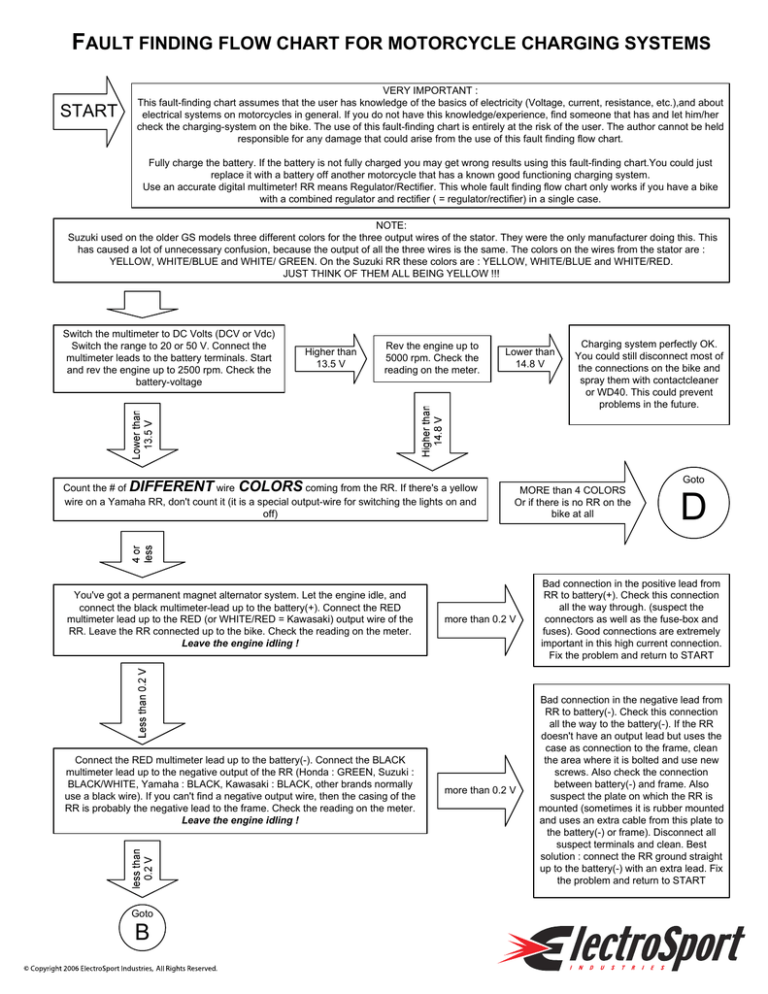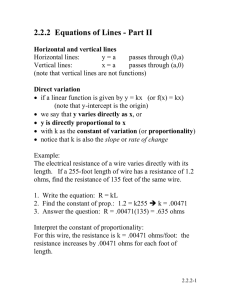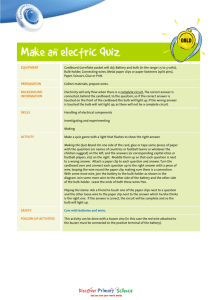start fault finding flow chart for motorcycle charging
advertisement

FAULT FINDING FLOW CHART FOR MOTORCYCLE CHARGING SYSTEMS START VERY IMPORTANT : This fault-finding chart assumes that the user has knowledge of the basics of electricity (Voltage, current, resistance, etc.),and about electrical systems on motorcycles in general. If you do not have this knowledge/experience, find someone that has and let him/her check the charging-system on the bike. The use of this fault-finding chart is entirely at the risk of the user. The author cannot be held responsible for any damage that could arise from the use of this fault finding flow chart. Fully charge the battery. If the battery is not fully charged you may get wrong results using this fault-finding chart.You could just replace it with a battery off another motorcycle that has a known good functioning charging system. Use an accurate digital multimeter! RR means Regulator/Rectifier. This whole fault finding flow chart only works if you have a bike with a combined regulator and rectifier ( = regulator/rectifier) in a single case. NOTE: Suzuki used on the older GS models three different colors for the three output wires of the stator. They were the only manufacturer doing this. This has caused a lot of unnecessary confusion, because the output of all the three wires is the same. The colors on the wires from the stator are : YELLOW, WHITE/BLUE and WHITE/ GREEN. On the Suzuki RR these colors are : YELLOW, WHITE/BLUE and WHITE/RED. JUST THINK OF THEM ALL BEING YELLOW !!! Switch the multimeter to DC Volts (DCV or Vdc) Switch the range to 20 or 50 V. Connect the multimeter leads to the battery terminals. Start and rev the engine up to 2500 rpm. Check the battery-voltage Higher than 13.5 V Rev the engine up to 5000 rpm. Check the reading on the meter. Count the # of DIFFERENT wire COLORS coming from the RR. If there's a yellow wire on a Yamaha RR, don't count it (it is a special output-wire for switching the lights on and off) You've got a permanent magnet alternator system. Let the engine idle, and connect the black multimeter-lead up to the battery(+). Connect the RED multimeter lead up to the RED (or WHITE/RED = Kawasaki) output wire of the RR. Leave the RR connected up to the bike. Check the reading on the meter. Leave the engine idling ! Connect the RED multimeter lead up to the battery(-). Connect the BLACK multimeter lead up to the negative output of the RR (Honda : GREEN, Suzuki : BLACK/WHITE, Yamaha : BLACK, Kawasaki : BLACK, other brands normally use a black wire). If you can't find a negative output wire, then the casing of the RR is probably the negative lead to the frame. Check the reading on the meter. Leave the engine idling ! Goto B Lower than 14.8 V Charging system perfectly OK. You could still disconnect most of the connections on the bike and spray them with contactcleaner or WD40. This could prevent problems in the future. MORE than 4 COLORS Or if there is no RR on the bike at all Goto D more than 0.2 V Bad connection in the positive lead from RR to battery(+). Check this connection all the way through. (suspect the connectors as well as the fuse-box and fuses). Good connections are extremely important in this high current connection. Fix the problem and return to START more than 0.2 V Bad connection in the negative lead from RR to battery(-). Check this connection all the way to the battery(-). If the RR doesn't have an output lead but uses the case as connection to the frame, clean the area where it is bolted and use new screws. Also check the connection between battery(-) and frame. Also suspect the plate on which the RR is mounted (sometimes it is rubber mounted and uses an extra cable from this plate to the battery(-) or frame). Disconnect all suspect terminals and clean. Best solution : connect the RR ground straight up to the battery(-) with an extra lead. Fix the problem and return to START Is there an RR on the bike ? (somewhere on the frame under the bodywork) No Switch the multimeter to DC-Voltage (DCV or Vdc) Range 20 or 50V. Connect the multimeter-leads to the battery-terminals. Start the engine and rev it up to app.5000rpm. Check the voltagereading. Stop the engine. Disconnect the blockconnector to the generator closest to the engine. This connector must have at least three YELLOW (or WHITE = Yamaha) wires in it and one or two extra ones. Switch the multimeter to the lowest Ohms-range. measure the resistance between the two other wires, or between the single extra one (apart from the YELLOW ones) and the engine-casing. You have a reading lower than 3 Ohms or higher than 10 Ohms Connect one spare wire to the battery(+) terminal and connect it up to one of the extra wires that are in the blockconnector, apart from the YELLOW (or WHITE = Yamaha) wires. Connect a second spare wire between the battery(-) and the other extra wire in the connectorblock. If you have only one extra wire, only connect the battery(+) wire to this one. Make sure the battery(-) is still connected to the frame. Switch the multimeter to AC-Volts, range at least 100 V (ACV or Vac). Start the engine and rev it up to app. 5000 rpm. Connect the multimeter-leads up between two of the YELLOW (or WHITE = Yamaha) wires. Check reading on multimeter. Switch one of the multimeter-leads to another YELLOW wire and check the reading again. Then switch the other multimeter-lead and check the reading again. You have an integrated generator (car-type, with built in regulator and rectifier). Most of the problems with this kind of generator are bad connections, from generator to battery (battery doesn't charge), or a burned out regulator (battery-voltage too high) Sometimes the generator itself is at fault. You could check the resistance of the fieldwinding (around 5 Ohms) and the state the brushes are in. Otherwise leave it to an expert. After solving the problem, return to START Higher than 14.8 V RR at fault. Voltage is not regulated properly. Check voltage on the BROWN (Yamaha, Kawasaki), BLACK (Honda) wires. If it is lower than battery voltage, you have a bad connection between battery and RR through the ignition switch. Fix this bad connection, and/or replace the RR and return to START The fieldwinding in the generator or the brushes to the rotor are at fault. If there are any brushes inside the generator, disconnect them and measure the resistance between the two copper sliprings on the rotor. These are the rings on which the brushes run. C Rotor at fault. Replace it with a new one, and return to START (If there are no brushes inside the generator, replace the fieldwinding or if that's not possible separately, replace the whole stator and return to START) Wiring to the brushes or the brushes themselves at fault. Replace the brushes, check the wiring to the brushes and return to START The three readings are not equal, or they are below 50 Volts (AC) Stator at fault. Replace stator and return to START Stop the engine. Switch the multimeter to DC-Voltage (DCV or Vdc). With the block-connector disconnected as above, connect the multimeter-leads up to the two extra wires in this connector (apart from the three YELLOW wires), this in the connector-block emerging from the wiring-loom, not the other side going to the generator. If there's only one extra wire, connect it to one multimeter-lead and connect the other multimeterlead to the engine-casing. When you switch on the ignition, Check the reading on the display. Goto resistance lower than 3.6 Ohms or higher than 6 Ohms No reading or a reading lower than 10 V (DC) RR at fault. Replace it with a new one and return to START Disconnect the RR from the bike. Switch the multimeter to the DIODE-TEST function. (The reading on the display will be in VOLTS now, not in Ohms!) Connect the RED multimeter-lead to the RED (or WHITE/RED = Kawasaki) output wire of the RR. Connect the BLACK multimeter-lead to one YELLOW (or WHITE = Yamaha) wire. Check the reading. Repeat this procedure for the two other YELLOW wires. The meter shows 1.00 V or lower on one of the three tests. Connect the BLACK multimeter-lead to the red (or white/red = Kawasaki) output wire of the RR. Connect the RED multimeterlead to one YELLOW (or WHITE = Yamaha) wire. Check the reading. Repeat this procedure for the two other YELLOW wires. The meter shows lower than 0.2 V or higher than 1.0 V on one of the three tests Connect the BLACK multimeter-lead to the negative output wire of the RR (Kawasaki : BLACK, Yamaha : BLACK, Honda : GREEN, Suzuki : BLACK/WHITE). If there is no output wire, connect the black multimeter-lead to the RR case Connect the RED multimeter lead to one YELLOW (or WHITE = Yamaha) wire. Check the reading. Repeat this procedure for the two other YELLOW wires. The meter shows 1.00 V or lower on one of the three tests. Connect the RED multimeter-lead to the negative output wire of the RR (Kawasaki: BLACK, Yamaha : BLACK, Honda : GREEN, Suzuki : BLACK/WHITE ). If there is no output wire, connect the BLACK multimeter-lead to the RR-case Connect the BLACK multimeter-lead to one YELLOW (or WHITE = Yamaha) wire. Check the reading. Repeat this procedure for the two other YELLOW wires. The meter shows lower than 0.2 V or higher than 1.0 V on one of the three tests As this was the last test, the only thing that can be at fault is the battery itself. replace it with a known good fully charged battery and return to START RR is at fault, replace it with a new one and return to START If you have an RR with 4 different wire COLORS emerging from it find the switched +12V supply input. (Normally Honda : BLACK, Suzuki : ORANGE, Yamaha : BROWN, Kawasaki : BROWN, otherwise check the wiring-diagram for the extra wire coming from the ignition-switch). Connect the red multimeterlead to the battery(+) and the black multimeter-lead to the switched +12V input-wire (the one you just found). Leave the RR fully connected up to the bike and let the engine idle. Switch on the lights. Check the reading on the meter. more than 0.2 V Stop the engine. Disconnect the wires coming from the stator. These are usually three YELLOW (or WHITE = Yamaha) wires. Switch the multimeter to Ohms, the lowest range on the meter. Measure the resistance between all three wires coming from the stator, so you need to take three readings. Connect one of the multimeter-leads up to one of the three YELLOW (or WHITE = Yamaha) wires. Connect the other multimeter lead up to the enginecase. Check the reading on the meter. Make sure the connection to the engine case is a good one ! C One of the readings is lower than 0.5 Ohms or higher than 2 Ohms You have any reading lower than 100 Ohms Check the display, your meter might be showing kilo Ohms or Mega Ohms , (0.1k Ohms is 100 Ohms, 0.45M Ohms is 450 k Ohms is 450,000 Ohms.) Switch the multimeter AC-Voltage (Range at least to 100 Vac). Make sure you DON'T switch it to DC-Voltage (=DCV or Vdc). Connect the multimeter leads between two of the three YELLOW (or WHITE = Yamaha) wires coming from the stator. Start the engine and rev it up to app. 5000rpm. Check the reading on the meter. Switch one of the multimeter leads to another YELLOW (or WHITE) wire and check the reading again. Switch the other multimeter-lead to another YELLOW (or WHITE) wire, and check the reading again. Goto Bad connection from the battery(+) through the ignition switch to the switched +12V supply-input on the RR. Check the whole electrical circuit. This is one of the most difficult faults to find. Suspect the ignition-switch itself, the fuse-box and its connections. The RR thinks the batteryvoltage is too low while the actual voltage is correct or too high. Disconnect all terminals and clean them with contact-cleaner. If you have fixed the problem, return to START The three readings are not equal, or one of them is below 50 Volts (AC) Stator is at fault. Replace the stator and return to START



